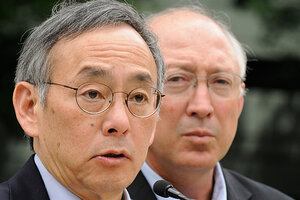As BP stumbles, an expanding federal role in Gulf oil spill
After BP's repeated failed attempts to cap the well at the center of the Gulf oil spill, the Obama administration is gradually becoming more involved. This week, it has sent two cabinet members to the scene and devoted more of its science resources to the relief effort.

Energy Secretary Steven Chu (l.) and Interior Secretary Ken Salazar hold a press conference outside the BP command center in Houston Wednesday to address the Gulf oil spill.
Pat Sullivan/AP
Two Obama administration officials arrived in Houston Wednesday to help bring the federal government's resources to bear on a wellhead leaking more than 200,000 gallons of oil a day into the Gulf of Mexico.
The arrival of Interior Secretary Ken Salazar and US Energy Secretary Steven Chu marked a subtle shift in the effort to stem the flow of oil. Federal officials insist that they are not taking over operations from BP, which is responsible for the cleanup and recovery efforts. But their presence here speaks to the fact that BP has now exhausted its most immediate and obvious solutions to stop renegade wellhead, and none appear to have had an effect.
IN PICTURES: Louisiana oil spill
The hope is that federal resources can act as reinforcements. Among these resources:
- Secretary Salazar has created an oversight board to regulate recovery operations.
- Salazar is also bringing in federal experts and equipment to monitor the situation and to come up with solutions for both minimizing the oil’s impact and stopping the spill. His first appointment was Marcia McNutt, the director of the US Geological Survey, who will coordinate efforts between BP engineers and federal scientists.
- Scientists from the Department of Energy's national laboratories will be using supercomputers to help give BP engineers a better handle on the situation. For example, they will conduct experiments around the damaged wellhead, they will model the riser – the crumpled pipe venting oil into the Gulf – to understand seafloor conditions, and they will use gamma radiography to create better visuals of the oil flow. Currently, BP is unsure of the actual flow rate, which can help engineers determine how badly the equipment is damaged and where all the oil leaks might be.
Until recently, there has been a sense that BP could handle the load from its command center in its US headquarters in Houston. Now, there is a greater appearance of all hands on deck. In a conference call to reporters Monday BP Chief Executive Tony Hayward called the enterprise “a global industry effort.”
The arrival of two cabinet secretaries on the ground is part of the White House’s increased efforts this week to show it is addressing the spill in a hands-on way. The oil has already reached the shorelines of coastal islands off the Alabama and Louisiana coasts this week, and dozens of dead water mammals such as dolphins and sea turtles have washed up on shore.
Since the April 20 explosion of the Deepwater Horizon oil rig, BP, which leased the rig and owns the well, has conducted a series of efforts to stop the rush of oil from the damaged wellhead and contain the oil from spreading further into the Gulf. Efforts to treat the oil that has already escaped are continuing to keep the oil from hitting mainland shorelines, but undersea efforts – from using robotic arms to turn off a preventative valve to a four-story dome – have failed.
BP Chief Operating Officer Doug Suttles said he was encouraged by “the comments and sense of optimism” of both Salazar and Secrertary Chu, and that their assistance will help his team “take no action which can make the situation worse.”
In addition to his its remediation goals, the Interior Department is also set to conduct a $29 million study of the safety of offshore drilling in the gulf. A moratorium on new leases to drill will not lift until that report is complete.
IN PICTURES: Louisiana oil spill
Related:
